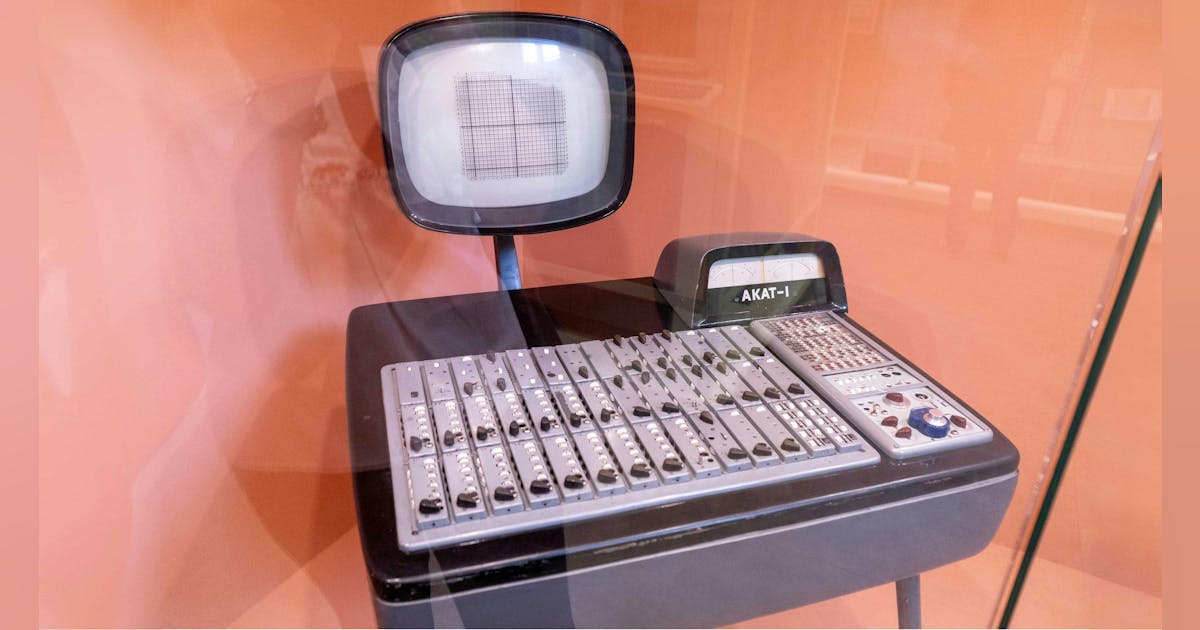In university, one of our EE lab assignments was to choose any real-world system to model, create the differential equation transfer function(s), wire up the components in an Analog Computer using patch cords (I believe our A.C. was this one) to provide both the input stimulus (usually by an integrated function generator), implement the differential equation(s), and define a way to look at the output.
I chose to do an Estes model rocket, using mass, an approximation of aero drag, gravity, and the impulse curve that happened to be included with the rocket motor. An innate masochist, I also did the equations twice, splitting the signal path, where I could input sine and cosine fixed variables by potentiometer for launch angle. Thereby I could output the downrange and altitude voltage outputs into the x and y channels of a storage ‘scope.
This patchcorded analogous circuit did work, predicting the rocket would reach ~800 ft., iirc, depicted as voltage on the storage scope, displaying the rocket’s ballistic trajectory as a gorgeous parabola drawn in persistent phosphors. By varying the angle of launch pots, I could simulate rocket launch trajectories much faster and cheaper than conducting empirical launches needing telemetry.
It’s a bit disingenuous, though, for popular media to have made the general public think that rocket science like the Apollo space program was done by nerds with slide rules. Analog computing was heavily used by us cool kids in design simulations and test rigs because digital computers simply could not process the information in real-time (to this very day with some computational problems) or compressed time (which analog computing allows by changing frequency and scaling reactances accordingly). Other ones and zeroes stuff was crunched at NASA (they were a lead customer for IBM’s computer product definition) by an IBM 360 mainframe.
The specific configuration of analog computing blocks, using patchcords, created a bespoke analog computing solution of adequate precision to model my rocket’s altitude and range as an x and y voltage output destined for a storage ‘scope based on my transfer function differential equations. Analog computing is superior, in power dissipation and throughput, to the most powerful digital supercomputer, or anything companies like Altera, Intel, NVIDIA, or Xilinx/AMD have to offer when its precision is adequate for the application.
The Sum, Difference, Product, Integral, etc. of Its Parts
An Analog Computer’s circuit blocks can include the following key components/functions as plug-in cards for the system backplane, where some those functions can appear in plurality on a card function:
- An operational amplifier1 that can sum, subtract, and integrate signals
- A four-quadrant multiplier
- An accurate voltage reference to set “machine scale” and constants
- A comparator to sense voltages and provide a true/false indication
- Integrator (RC) precision-component networks
- 10-turn precision linear potentiometers to accurately set constants/coefficients
- Switches, patches, and inverting amplifiers
- Servo-motorized precision potentiometers in some machines
If you’ve been playing along here, you’ll already have clicked the link to the Analog Computer user manual that showcases its functional blocks and how to patchcord it for various operational functions. For the YouTube generation of learners, it seems like there’s some good stuff on analog computing here. If you have a favorite learning resource or reference on analog computing, please add it to the comments.
So, there. “Analog” components are simply the building blocks of an analog computer and nothing more. To be a bit pedantic, “Analog” is not really interchangeable with “Linear” (note that Bob Pease in his very first column also put “Linear” in quotes—I went back and searched his columns after I wrote this piece) because Analog Computers often use diodes, waveform clipping techniques, and other means to produce nonlinear outputs.
Nonlinearities
A non-obvious evolution of Analog Computers was the music synthesizer. At Cornell University, Robert A. Moog clearly repurposed the Analog Computer as a musical instrument, added a keyboard, and created value for performance artists by giving them control over nonlinear, nightmarish (to us engineers), circuit behavior. Things like excessive gain, clipping of signals, producing noise intentionally, using filters in the signal path, and starting it all off with square, triangle, VCO, variable duty cycle, and other function generators as signal path stimulus.
Moog’s approach, as I’ve successfully done in my product definition roles, was to engage lead customers/users in specifications development and early product evaluation/feedback to better assure product success.
These Analog Computer building -block abuses created non-organic instrumental sounds, with artists like Walter (now Wendy) Carlos (Moog’s lead, and first, customer) releasing a highly successful 1960s album featuring the music of Bach and Mozart on Moog’s Synthesizer,2 and Syrinx doing the intro theme to a futurist Canuck TV series. There were also heavy-metal artists like Edgar Winter using the ARP 26003 analog synth in the 70s, remoting its keyboard as a live-performance innovation, to create the huge headbanger hit “Frankenstein,” and with this “electro-pop” music taking a popular and fun ride mit ze Germans on the Autobahn, as well as giving us the spacey sounds of Jean Michel Jarre.
Notice that none of this synth-music genre was called “Analog Music” just because it had an Op Amp in it, or because it worked with continuous time signals.






